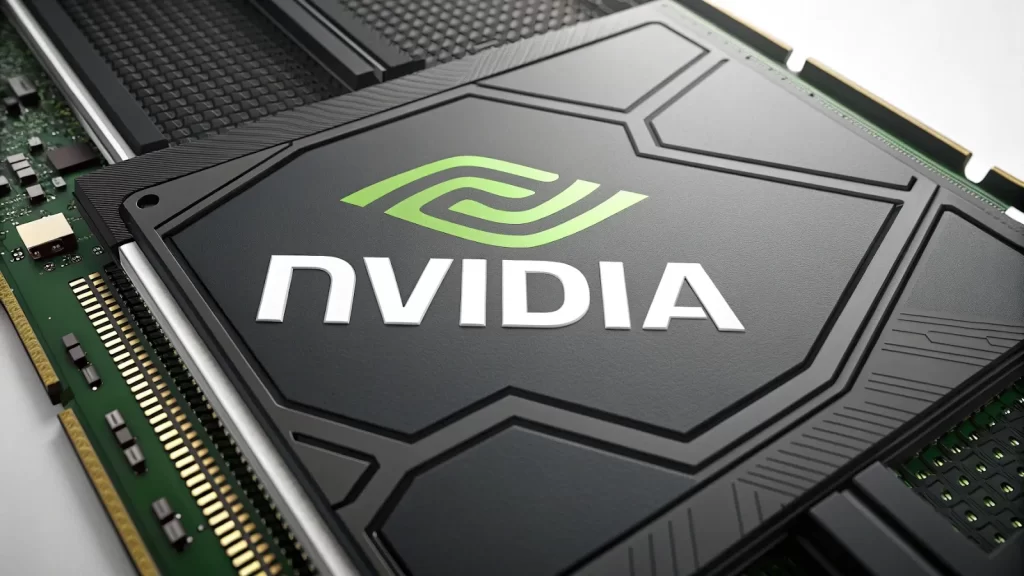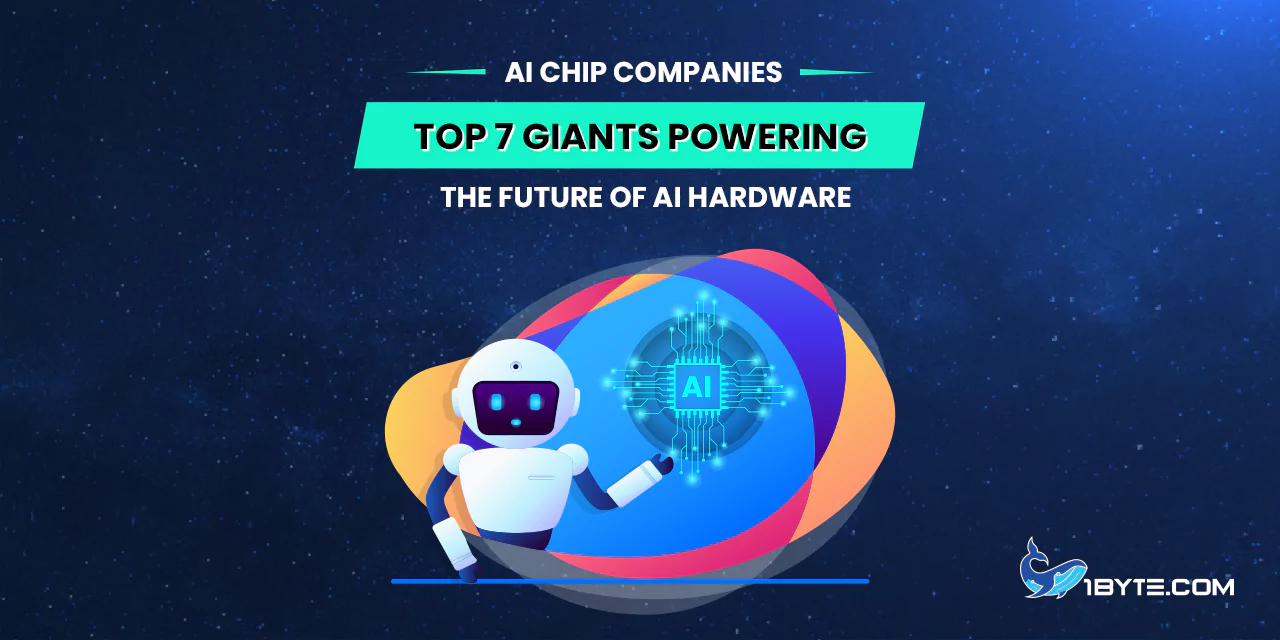AI chip companies are at the forefront of a computing revolution. These firms design specialized processors for machine learning, powering everything from cloud AI and data centers to smartphones and autonomous vehicles. Spending on AI hardware is surging: one industry report predicts the AI chip market could approach $400 billion by 2030. Hyperscale cloud providers and tech giants are pouring billions into AI chips to meet demand. Below we at 1Byte highlight seven leading AI chip companies, their latest innovations, and how their chips are used in real-world AI applications.
NVIDIA – The AI Chip Titan
NVIDIA leads the AI hardware market with its powerful GPUs. In 2023 the company shipped about 3.76 million data-center GPUs – over 98% of that market. These GPUs (notably the H100 and newer Blackwell series) are the backbone of cloud AI services and supercomputers. For example, NVIDIA’s new Blackwell B200 GPU packs ~208 billion transistors and delivers ~20 petaFLOPS of AI compute. This performance lets data centers train trillion-parameter language models with far fewer chips and energy (NVIDIA claims 2,000 Blackwell GPUs now equal 8,000 older GPUs in power use). High demand has driven NVIDIA’s revenue to record levels ($60.9 B in 2023, ~126% above 2022).

In practice, NVIDIA GPUs power OpenAI’s servers for GPT models, Google’s DeepMind research, and many corporate AI clouds. NVIDIA also supplies chips for robotics, autonomous vehicles (its DRIVE platform), and scientific computing. In short, NVIDIA’s dominance (≈98% share of AI GPUs) and ongoing innovations make it one of the market’s leading AI chip companies.
AMD – The Rising Challenger
Advanced Micro Devices (AMD) is quickly gaining ground among AI chip companies. AMD’s Instinct MI300 series of GPUs (launched late 2023) marked its first fully competitive AI accelerators for training and inference. These new GPUs, combined with AMD’s acquisition of Xilinx (FPGAs) and Pensando (smartNICs), have boosted its AI business. In Q1 2024 AMD’s data center segment – mostly driven by MI300 – grew 80% year-over-year to $2.3 billion. Analysts note that AMD’s AI GPU sales even “rival its CPU business” in recent quarters. Despite this growth, AMD still holds a relatively small slice of the AI chip market (around 5–7% as of 2024) because NVIDIA leads with roughly 80%.
However, AMD chips already power some of the world’s fastest systems. For example, the U.S. DOE’s Frontier exascale supercomputer uses 37,000 AMD Instinct GPUs (plus 9,400 AMD CPUs) to reach 1.1 exaflops. AMD aims to expand its share through continued R&D: its CDNA GPU architectures and in-house AI IP are optimized for large models and energy efficiency. In sum, AMD has emerged as a serious “challenger” to NVIDIA, with rising AI revenue and cutting-edge products (like MI300X) that enable big-model training.
Intel – The Legacy Player’s AI Push
Intel, long a leader in CPUs, is retooling its business for AI. It now offers AI accelerators (from its Habana Labs unit) and AI-optimized processors. For instance, Intel’s Gaudi AI chips (and the new Gaudi 3) target data-center training, and Movidius/Myriad NPUs serve edge devices and cameras. Despite this, Intel’s AI effort has had mixed results. The company once forecast over $500 million in Gaudi sales for 2024, but later scrapped that guidance. Intel CEO Pat Gelsinger has acknowledged that Gaudi adoption has been slower than hoped. Still, Intel’s extensive manufacturing and partnerships (with Microsoft Azure, Alibaba Cloud, etc.) give it reach.
Many companies use Intel Xeon servers with built-in AI instructions or accelerators for inference. Intel also custom-designs AI chip variants (e.g. the upcoming Lunar client AI processor) to compete. In short, Intel is pivoting toward AI chips and investing heavily, but it currently trails NVIDIA and AMD. Its continued shift – including Xeon CPUs with AI boosts and future chips like Ponte Vecchio – will test whether the “legacy” giant can reclaim market share.
Google (Alphabet) – The AI Infrastructure Powerhouse
Google (Alphabet) is a “fabless” AI chip company through its Tensor Processing Units (TPUs). Google’s TPUs are custom accelerators built for its own needs: they power Google Search AI, Translate, Bard (Gemini), and Google Cloud AI services.

The latest TPU generation is impressive: a single TPU v5p pod (2024) contains 8,960 TPU chips – over twice the size of the prior TPU v4 pods. Each TPU v5p chip also delivers 2× the compute power and 3× the memory of the previous version. Together, a TPU pod provides massive parallelism for training giant models. Google says these TPU clusters make it feasible to train trillion-parameter models far more efficiently than before. Industry analysts even named Google a leader in AI infrastructure for its cloud hardware and software stack.
Practically, any service or customer using Google Cloud AI is likely running on Google’s TPU hardware. Google’s approach – deep integration of TPUs with its software frameworks – lets it scale AI research internally and offer powerful AI instances to enterprises. In summary, Google’s TPUs are a central part of its AI strategy, enabling the company to innovate rapidly ahead of other AI chip companies.
Apple – Device AI with Neural Engines
Apple isn’t a chipmaker in the traditional sense, but it designs industry-leading AI processors for its products. Every new Apple chip (A-series for iPhone/iPad and M-series for Mac) includes a Neural Engine for AI tasks. For example, Apple’s March 2025 M3 Ultra chip has a 32-core Neural Engine and 184 billion transistors. This powerhouse can run extremely large AI models on-device – Apple claims it can handle a 600-billion-parameter language model directly on a Mac Studio.
In everyday use, Apple’s AI silicon enables features like face recognition, voice dictation, camera image processing, and real-time language translation, all without needing to contact the cloud. Apple even markets these capabilities under the “Apple Intelligence” brand. By tightly coupling hardware and software, Apple chips deliver efficient on-device AI for privacy and speed. In short, Apple’s vertically integrated chips are a giant in mobile AI: they power Siri’s voice assistant, camera enhancements (like computational photography), and new on-device AI features on Macs and iPhones.
Qualcomm – Mobile and Edge AI Leader
Qualcomm is one of the most dominant AI chip companies for smartphones and IoT devices. Its Snapdragon system-on-chips integrate powerful AI engines (the Hexagon DSP and NPU) for on-device intelligence. Nearly every flagship Android phone (Samsung Galaxy, Google Pixel, etc.) uses Snapdragon chips. For instance, the Snapdragon 8 Gen 3 (2023) is one of the new “AI smartphone” chips, featuring an NPU capable of running large models on device.
IDC forecasts that AI-enabled smartphone shipments will jump 364% in 2024 (to about 234 million units), and most of these phones use Qualcomm’s or similar AI chips. In phones, Qualcomm’s AI hardware powers camera scene detection, portrait mode, and always-on voice assistants. Qualcomm is also pushing AI in PCs and cars: its new Snapdragon X Elite PC chip (for Windows Copilot+ laptops) has an integrated AI accelerator, and its automotive SoCs (Snapdragon Ride) target self-driving sensors. In summary, Qualcomm’s silicon is at the heart of mobile AI. Its chips not only run apps but also process AI tasks locally (language translation, AR apps, etc.), making Qualcomm a giant in edge AI.
Graphcore – The AI Chip Innovator
Graphcore is a UK startup that builds specialized AI processors called IPUs (Intelligence Processing Units). Unlike GPUs, Graphcore’s IPUs use a unique architecture tailored for the parallelism in neural networks. Its latest chip, the Bow IPU (2023), uses wafer-on-wafer fabrication and can perform roughly 350 trillion operations per second. Four Bow IPUs in a server deliver about 1.4 petaFLOPS of AI compute. These systems are aimed at AI researchers and enterprises experimenting with cutting-edge models. While Graphcore’s sales have been modest so far, it has attracted huge investment – even being acquired by SoftBank in 2024 to bolster AI efforts.
For example, Microsoft and Dell were early investors in Graphcore, using its IPUs in cloud research projects. In practice, Graphcore machines are used in some AI labs as an alternative accelerator. Overall, Graphcore represents the innovative edge of AI chips: it experiments with new designs (like the Bow IPU’s interleaved wafers) to push AI training performance in fresh ways.
Leverage 1Byte’s strong cloud computing expertise to boost your business in a big way
1Byte provides complete domain registration services that include dedicated support staff, educated customer care, reasonable costs, as well as a domain price search tool.
Elevate your online security with 1Byte's SSL Service. Unparalleled protection, seamless integration, and peace of mind for your digital journey.
No matter the cloud server package you pick, you can rely on 1Byte for dependability, privacy, security, and a stress-free experience that is essential for successful businesses.
Choosing us as your shared hosting provider allows you to get excellent value for your money while enjoying the same level of quality and functionality as more expensive options.
Through highly flexible programs, 1Byte's cutting-edge cloud hosting gives great solutions to small and medium-sized businesses faster, more securely, and at reduced costs.
Stay ahead of the competition with 1Byte's innovative WordPress hosting services. Our feature-rich plans and unmatched reliability ensure your website stands out and delivers an unforgettable user experience.
As an official AWS Partner, one of our primary responsibilities is to assist businesses in modernizing their operations and make the most of their journeys to the cloud with AWS.
Conclusion
AI chip companies are the backbone of today’s tech revolution. From training massive language models to enabling on-device intelligence, these firms are shaping how artificial intelligence is built and used. Giants like NVIDIA and AMD dominate the data center race, while companies like Google and Apple innovate with custom AI hardware for cloud and personal devices. Meanwhile, challengers such as Qualcomm and Graphcore push boundaries in mobile and experimental computing.
As AI adoption grows across industries, the role of ai chip companies will only become more critical. Their chips decide how fast, efficient, and scalable tomorrow’s AI will be. Watching these top players closely isn’t just smart—it’s essential for understanding where the future of computing is headed.

